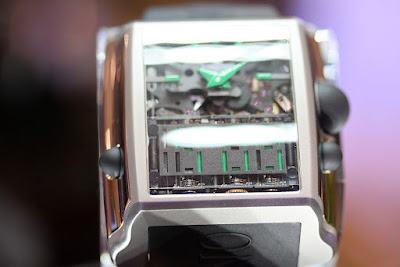Opus 8 Press Release;
OPUS 8: THE ART OF DIGITAL EMOTION
REINTERPRETATION OF A (R)EVOLUTION
Rooted in the Pop Art moment of the 1970s, Digital Art and Technology have revolutionized our way of life and continue to influence contemporary art and culture. Allowing artists to create works of extreme complexity, these same advances in digital technology have also transformed the art of modern watchmaking. Armed with the avant-garde and innovative spirit that defined this decade, Opus 8 represents a continuation of this technological and artistic (r)evolution...
A MECHANISM INSPIRED BY A GAME
An exceptional and advanced timepiece, Opus 8 utilizes hand-wound mechanical movements to create a modern, digital time display. Inspired by pin art games, which create 3D impressions of objects pressed against them, the numbers in the display will only appear “upon request,” activated by a bolt on the right hand side of the case. Nothing appears until the mechanism is wound.
A plate joins together small segments, both mobile and fixed. Just underneath is a disc driven by the movement, which turns independently in real time. When the mechanism is wound, the pieces adjust to display the time. As the plate descends, the small segments remain visible, “blocked” by the crystal, allowing the hour to be read for 5 seconds. Technically, all functions are related, enabling everything to be displayed on demand – the minute hand turns the hour that then turns the AM/PM function.
The dial’s microbead blasted coating is similar to that of a calculator, while the segments are made of black anthracite with polished sides. As innovative in materials, as in mechanics, the sides of the segments are crafted of amorphous carbon. A material more commonly known in Formula 1 racing, Garinaud’s team successfully adapted it to use for watch microparts. The specialized material has an extremely low friction coefficient and highly resistant coating. Wear, blockages and material discharge become almost non-existent.
THE INNOVATION’S MAGIC
In addition to a modern, sophisticated technique, Opus 8 features a strikingly original dial display. On the left is a four-digit hour display – two for the hour and two for the time of day (AM/PM). When it is 20h00, the watch will display 08PM. On the right is an innovative minute counter, with a layout and display from bottom to top. Set in 5 minute segments (precision being secondary), the 5 minute indicator is an arrow-shaped ring. The hour and minute numbers recalls the symmetrical hexagonal typography found in liquid crystal mechanics.
A VERY “SEVENTIES CASE”
With its imposing rectangular dimensions – 43mm wide, 41mm long, 13 thick – Opus 8’s bold, graphic shape resembles a retro-style television set. The case front has a resolutely digital display with its 4mm-thick domed crystal blocking the segments . With the display winding bolt located on the right and the winding crown on left, the mechanism has a movement rotation of 180 °. The display of the hour is not possible during winding. In the middle, an opening allows us to admire the heart – the balance. The movement’s back is decorated like a printed circuit, with lines leading to the various time elements. At the top, the hours (H) and the minutes (M). On the left, the periods of the day (AM/PM), and on the right, the 48-hour power reserve indicator (PRI). At the bottom, two lines indicate the co-designers of the watch, Garinaud & CSH (Cellule de Spécialités Horlogères), and the serial number.
OPUS 8 TECHNICAL DESCRIPTION
MOVEMENT: TYPE: Mechanical, elliptical, with mechanical digital display module, Manual winding
DISPLAY: Hours, minutes (every 5 minutes), AM/PM.
FREQUENCY: 3 Hz
MAIN DIAMETER: 35 mm
DISPLAY MODULE: 35.5 mm by 22.5 mm
JEWELS: 44
COMPONENTS: 437
SEGMENTS: 138
POWER RESERVE: 48 hours
FUNCTIONS: On the face: Digital display indicated by segments: Hour (AM/PM) and
minutes (every 5)
On the back: Digital display indicated by discs: Hour (AM/PM) and
minutes (every 5)
Power reserve also indicated on the back of the watch
CASE: MATERIAL: White gold
DIMENSIONS: WIDTH: 45.8 mm
LENGTH: 33.5 mm
LEFT: Crown for setting the time and winding
RIGHT: Winding bolt for digital displays
DIAL: Display module: black anthracite segments with polished sides
Side of segments crafted from amorphous carbon
Hours, minutes and letters in digital form
CRYSTAL: Anti- reflective Sapphire, 4 mm
WATCHSTRAP: Leather
WATER RESISTANCE: 30 meters
LIMITED EDITION: 50 pieces
The Opus program was launched by Maximilian Büsser & Harry Winston in 2001, to encourage a new interest for unlimited freedom and innovation in technical watchmaking. Partnering with independent watchmakers, each year the Opus program develops rare timepieces never before seen or imagined within the industry.
 Some real world pics I shot at Baselworld of the de Grisogono dG Meccanico with roller mechanical digital display. Read my original posting here-->Link
Some real world pics I shot at Baselworld of the de Grisogono dG Meccanico with roller mechanical digital display. Read my original posting here-->Link


 Original Meccanico dG rendering
Original Meccanico dG rendering

















































